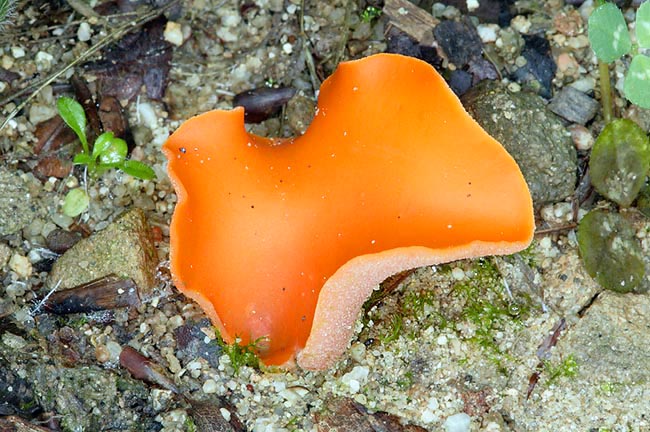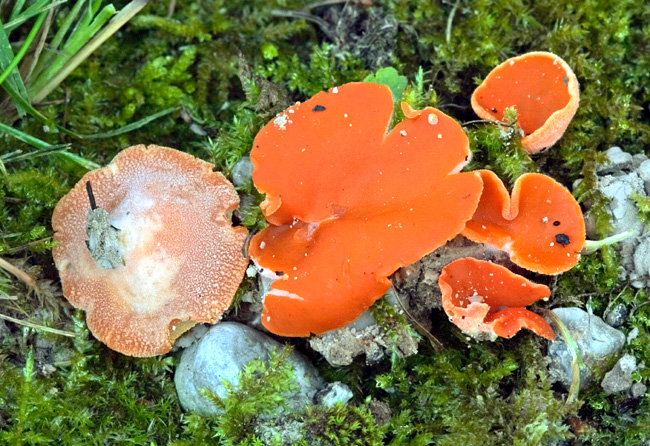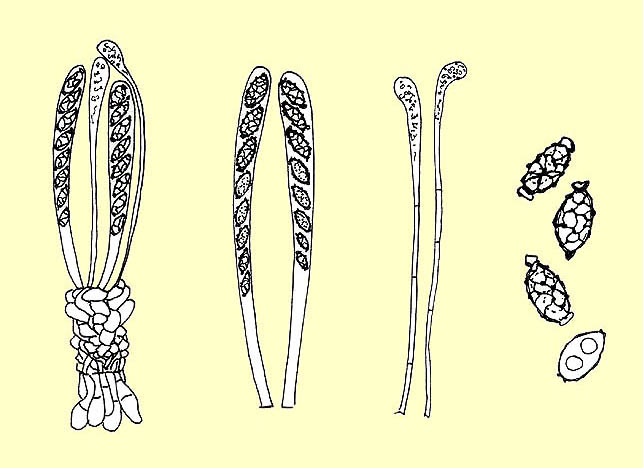
Text © Maria Tullii

English translation by Mario Beltramini

Aleuria aurantia grows on barren soil, forming 1-10 cm cups © Giuseppe Mazza
Family: Humariaceae Velenovsky, 1934.
Genus: Aleuria Funkel, 1870.
Aleuria aurantia (Persoon : Fries) Fuckel 1870.
The term “aurantia” comes from the Latin “malum aurántium” which means colour of the orange.
Description of the Family and of the Genus
To this family belong sessile carpophores, with a more or less hairy margin, all terricolous fungi; the hymenium covers the apothecium, the asci are operculate with non amyloid apex.
To the genus Aleuria are ascribed small and medium-sized fungi, with sessile apothecium or with a very short peduncle, almost flat or deeply and irregularly cyathiform.
The hymenophore is smooth, with a bright colour going from the yellow to the pinkish orange, the outer surface is concolorous, but paler, and may be smooth or pruinose. Non amyloid, octo-sporic asci, hyaline spores, ornately.

The bright orange hymeneal surface contrasts with the yellowish white and tomentose outer side © Maria Tullii
Description of the species
Apothecium: sessile from 1 to 8(10) cm of diameter, cup-shaped; margin initially straight, then more or less undulated, at times flattened, at times fissured. The carpophores are gregarious, often crowded on each other so much that the shape varies in even remarkable manner due to the pressure of the carpophores.
Hymenophore: hymenial bright orange surface, yellowish-white outer surface, finely tomentose. The flesh is thin and brittle, whitish.
Habitat: on barren soil, in the open spaces and along the margins of the paths, in numerous groups, late summer-autumn.
Spores: ellipsoidal, 14(17) × 9(11) µm, uniseriate in the ascus, initially smooth and with two guttulae, then covered by thick network forming two apiculi at the extremities.
Asci: octosporic, 12-13 × 200-220 µm, shaped like a cylinder, not amyloid.
Paraphysis: thin, slightly clavate at the margin, as an average, longer than the asci, containing, in the upper part, bright orange pigments which react with the iodated substances assuming a greenish colouring.

Aleuria aurantia: excipulum section, asci, paraphysis and spores © Maria Tullii
Remarks
It’s a species characterized by: a particular habitat, as a matter of fact, it grows on barren, clayed soil or on stony paths, never inside the wood.
It has a nice bright orange colour in the hymeneal part, whilst the outer surface is paler and dandruff-like; there are no hairs at the margin and the outer part.
Possible mistakes may happen with apotheci having the same colour, the same habitat and the same size, such as: Melastiza chateri (W.G. Smith) Boudier, which reaches the same size and more or less the same colour, but has the margin clearly covered by thick hairs of brownish colour.
Some species of the genus Scutellinia (Cooke) Lambotte 1887, which, however, are smaller carpohores and have the margin and the outer surface covered by thick hairs, even 2 mm long.
Synonyms
Peziza aurantia Pers. 1800 (basionym); Helvella coccinea Bolton 1789; Scodellina aurantiaca (Persoon) S.F. Gray 1821.
→ For general notions about Fungi please click here.
→ To appreciate the biodiversity of MUSHROOMS please click here.
